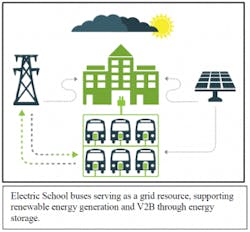Microgrids Create a Second Shift for School Buses after they Deliver the Kids
Imagine community microgrids with electric school buses that don’t just shuttle kids, but act as appliances. And not just any appliances, but ones that keep the power on in schools so that they can serve as emergency shelters during a disaster.
That’s the kind of analysis going on within the Vermont Energy Investment Corporation, a non-profit organization already known for being ahead of the curve as creator of the first all-energy efficiency utility, Efficiency Vermont.
When VEIC created the efficiency utility in 1999, it was seeking solutions to a relationship problem: Utilities have an inherent conflict when it comes to handling energy efficiency programs. They are being asked to promote programs that ultimately reduce their sales. Efficiency Vermont was the answer because it has no incentive except to save energy.
Now VEIC is mulling another relationship that’s not easy for utilities. There is a lot of talk about using fleets of electric cars as virtual power plants. Their batteries can act as energy storage and provide back-up power, demand response, or other grid services.
“Utilities are beginning to think about, what is this big mobile appliance? They have never dealt with something that moves around, they don’t know about travel behavior,” said Karen Glitman, VEIC director of transportation efficiency.
At the same time, transportation authorities know little about electric load management, demand response or ancillary grid services. The two sectors don’t speak the same language.
So who — and how — will the U.S. manage this large new resource, the aggregated electric vehicle fleet, this amalgamation of the transportation vehicle, virtual power plant and big electric customer?
The Transportation Utility
The solution again may be to set up a separate entity, what VEIC calls an efficiency transportation utility, modeled after its electric energy efficiency utility, Glitman said.
As a start in exploring this possibility, VEIC is looking deeply at how the electric vehicle will serve electricity markets.
That’s where the double-duty school bus comes into play. Within a microgrid, it looks like the school bus may be a better grid resource than the car. It would take only 17 electric school buses to do the job of about 700 electric cars, according to Glitman. That’s the amount needed to meet the 1 MW resource standard set by ISO New England to participate in its demand response market.
Track the emerging market for electric vehicles in microgrids by subscribing to the Microgrid Knowledge Newsletter. It’s free.
It’s not just its large battery that makes the school bus an effective energy storage device. Buses operate on a ‘duty cycle’ that dovetails well with utility needs.
With little need to shuttle children in the summer, school buses sit idle. So they can act as generation appliances. By night they can charge and by day release the charge onto the grid to serve the strong demand created by air conditioners.
School buses could prove to be particularly companionable with wind power, since wind tends to generate more power at night, when energy prices are low.
Credit: VEIC
In a microgrid, school buses offer an additional advantage, Glitman said. Many microgrids are built with storm planning in mind. Often these microgrids are set up to provide power to emergency shelters. And often the shelters are schools, just where the school buses are parked.
Biggest asset
In the near term, electric school buses are likely to provide demand response, rather than ancillary grid services. Demand response requires only unidirectional charging. The bidirectional charging needed to play in other grid markets — such as frequency — would require that retrofits be made to the buses, which would void their warranties, Glitman said.
That will change as manufacturers begin to install bidirectional charging features. Then several markets could open up for electric vehicles, depending on rules within the various wholesale markets in North America.
Of course, another question is who will aggregate the vehicles into a single power resource and then sell the resource into wholesale electricity markets? VEIC sees several possibilities. Utilities may play the role, or fleet owners, car manufacturers, demand-service providers or other third parties.
VEIC also is exploring electric vehicles earning renewable fuel credits, if the vehicles are charged with power from biofuels.
Riding in a Power Plant
Further into the future, the possibility exists that buses and other electric vehicles will be planned as power plants first, and transportation vehicles second. Some envision the day, Glitman said, where driverless “mobile generation storage,” moving from substation to substation, provides utilities with power and picks up people along the way.
“This is really about integrating the whole system,” she said. “We’re thinking about renewables as a big play in this space because renewables need storage, and that’s what EVs can help provide. So it’s renewables, it’s microgirds, it’s the integration of mobile storage into a total energy system.”
VEIC has produced several reports about electric vehicles and the grid, among them, “Transportation Technical Reference Manual, A Guide to Characterize the Savings, Benefits, and Costs of Transportation Efficiency Measures.”
About the Author
Elisa Wood
Editor-in-Chief
Elisa Wood is the editor and founder of EnergyChangemakers.com. She is co-founder and former editor of Microgrid Knowledge.
